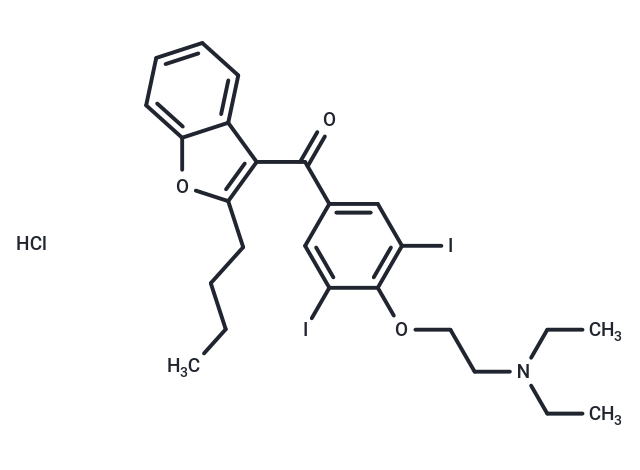 Your shopping cart is currently empty
Your shopping cart is currently empty

Amiodarone hydrochloride is an anti-anginal agent and a class III antiarrhythmic drug that inhibits potassium channels (including wild-type hERG channels and their tail currents, with an IC₅₀ of approximately 45 nM) as well as voltage-gated sodium channels. This leads to prolonged action potential duration in ventricular and atrial myocytes, resulting in reduced heart rate and vascular resistance. It activates ERK1/2 and p38 MAPK signaling pathways in fibroblasts, promoting cell proliferation and myofibroblast differentiation. Amiodarone hydrochloride is widely used in the study of supraventricular and ventricular arrhythmias and can also be used to establish pulmonary fibrosis animal models.

| Pack Size | Price | USA Warehouse | Global Warehouse | Quantity |
|---|---|---|---|---|
| 500 mg | $36 | In Stock | In Stock | |
| 1 g | $47 | In Stock | - |
| Description | Amiodarone hydrochloride is an anti-anginal agent and a class III antiarrhythmic drug that inhibits potassium channels (including wild-type hERG channels and their tail currents, with an IC₅₀ of approximately 45 nM) as well as voltage-gated sodium channels. This leads to prolonged action potential duration in ventricular and atrial myocytes, resulting in reduced heart rate and vascular resistance. It activates ERK1/2 and p38 MAPK signaling pathways in fibroblasts, promoting cell proliferation and myofibroblast differentiation. Amiodarone hydrochloride is widely used in the study of supraventricular and ventricular arrhythmias and can also be used to establish pulmonary fibrosis animal models. |
| Targets&IC50 | K+-ATP channel:19.1 μM |
| In vitro | Amiodarone (AM) inhibits the intracellular conversion from thyroxine (T4) to triiodothyronine (T3) via 5'-deiodination (5'DI) without affecting the intracellular conversion from T4 to reverse T3 (rT3).1.25-25 mg/kg Amiodarone in the AV node and in anaesthetized dogs resulted in a decrease in sinus rate, a prolongation of the AV node effective and functional occlusion of the AV node, as well as frequency-dependent conduction delays. 50 mg/kg daily for 3-4 weeks Amiodarone in rabbit ventricular myocytes resulted in a significant reduction in iK and ito current densities without affecting ICA and IK1 densities. |
| In vivo | Amiodarone penetrates deeply into the lipid matrix of the membrane and is released very slowly from cardiac tissue during washout.Amiodarone inhibits fast sodium channels as well as slow calcium channels.Amiodarone also has non-competitive antiarrhythmic effects and regulates thyroid function and phospholipid metabolism.44-88 μM Amiodarone inhibits Vmax of guinea pig papillary muscle without affecting normal hematopoietic stem cells.44-88 μM Amiodarone inhibits Vmax of guinea pig papillary muscle without affecting normal hematopoietic stem cells. Amiodarone inhibits Vmax in papillary muscle without affecting the resting membrane potential, and this Vmax inhibition is potentiated in a frequency- or use-dependent manner as is the case with class I antiarrhythmic drugs.50-88 μM Amiodarone inhibits depolarization-induced spontaneous action potentials (aberrant automaticity) in ventricular myocardium and Purkinje fibers.50-88 μM Amiodarone inhibits depolarization induced action potentials (aberrant automaticity) in human ventricular muscle. |
| Synonyms | Nexterone, Amiodarone HCl, Amiodar HCl |
| Molecular Weight | 681.78 |
| Formula | C25H29I2NO3·HCl |
| Cas No. | 19774-82-4 |
| Smiles | Cl.c1(c2c(oc1CCCC)cccc2)C(=O)c1cc(c(c(c1)I)OCCN(CC)CC)I |
| Relative Density. | 1.58 g/cm3 |
| Color | White |
| Appearance | Solid |
| Storage | Powder: -20°C for 3 years | In solvent: -80°C for 1 year | Shipping with blue ice/Shipping at ambient temperature. | |||||||||||||||||||||||||
| Solubility Information | DMSO: 22.73 mg/mL (33.34 mM), Sonication is recommended. | |||||||||||||||||||||||||
| In Vivo Formulation | 10% DMSO+40% PEG300+5% Tween 80+45% Saline: 1 mg/mL (1.47 mM), Sonication is recommended. Please add the solvents sequentially, clarifying the solution as much as possible before adding the next one. Dissolve by heating and/or sonication if necessary. Working solution is recommended to be prepared and used immediately. The formulation provided above is for reference purposes only. In vivo formulations may vary and should be modified based on specific experimental conditions. | |||||||||||||||||||||||||
Solution Preparation Table | ||||||||||||||||||||||||||
DMSO
| ||||||||||||||||||||||||||
| Size | Quantity | Unit Price | Amount | Operation |
|---|

Copyright © 2015-2025 TargetMol Chemicals Inc. All Rights Reserved.